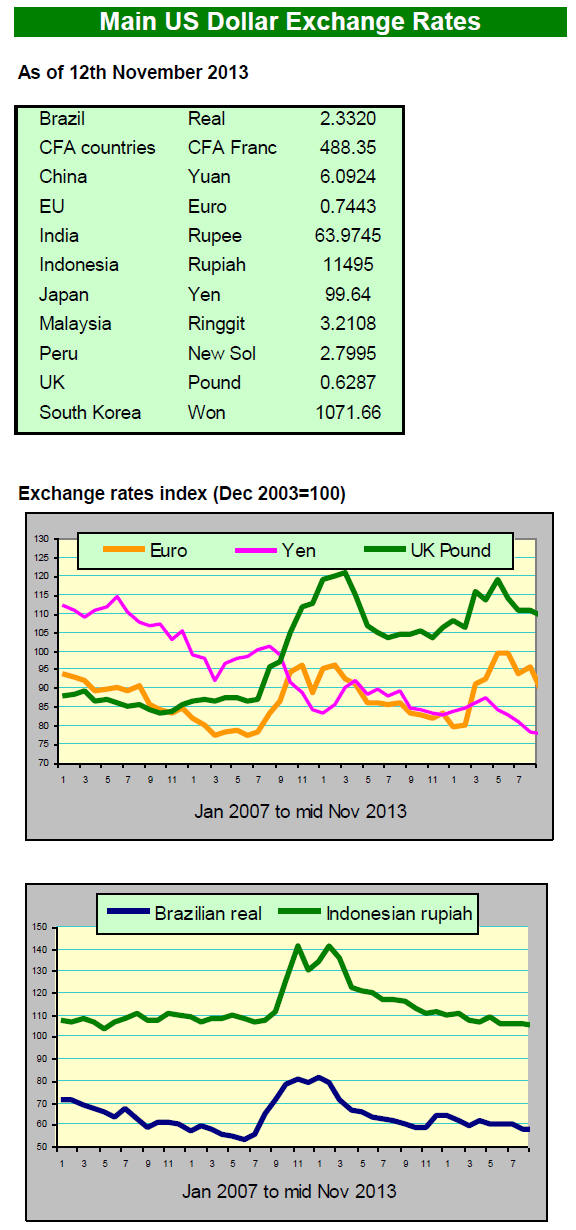2. GHANA
Forest Investment Programme fully funded
Ghana has received approval for a US$9.75 million
contribution from the Climate Investment Fund through
the African Development Bank to implement a Forest
Investment Programme.
The funding is intended to help reduce deforestation and
forest degradation, increase carbon stocks and reduce
poverty. This programme will engage communities in land
management to generate financial and environmental
benefits.
About 12,000 people, half of them being women, would
receive support in capacity building and equipment. They
will also benefit from financial incentives through benefitsharing
agreements to develop forestry, agro-forestry and
alternative livelihood activities. The initial stage of the
programme will be piloted in the forest areas in the
Western and Brong-Ahafo regions.
According to the Task Manager for the programme, Mr.
Albert Mwangi, ※Approval of this funding means that
Ghana can ramp up sustainability of its forest sector and
ensure that forest-related communities are both recipients
and creators of effective and climate-smart economic
solutions.§
The CIF was established in 2008, and is one of the largest
fast-tracked climate financing instruments in the world,
which provides developing countries with grants,
concessional loans, risk mitigation instruments and equity
through engaging local communities in REDD+ and
Enhancement of Carbon Stocks (ELCIR+)§ projects.
Inflation leaps by 5.4%
The Ghana Statistical Service (GSS) has announced that,
the producer price inflation year-on-year between
September 2012 and September 2013, increased by 5.4
percent, which represented an increase in producer
inflation by 0.7 percent relative to the rate recorded in
August 2013 (4.7 percent).
The month-on-month change in producer prices between
August 2013 and September 2013 was 1.9 percent.
According to the GSS statement, output in the mining and
quarrying sub-sector declined by 2.8 percent compared to
levels in August.
The GSS further said manufacturing output, which
constitutes more than two-thirds of the total industry,
increased by 1.82 percent to 12.6 percent for the year to
date while the rate of the utilities sub-sector remained
unchanged.
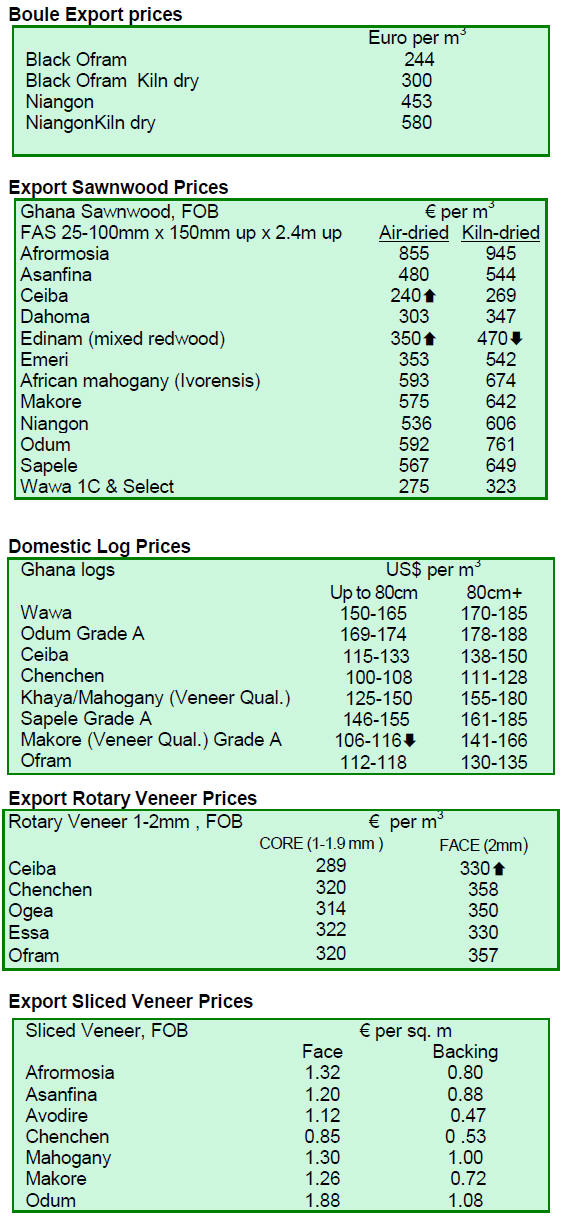
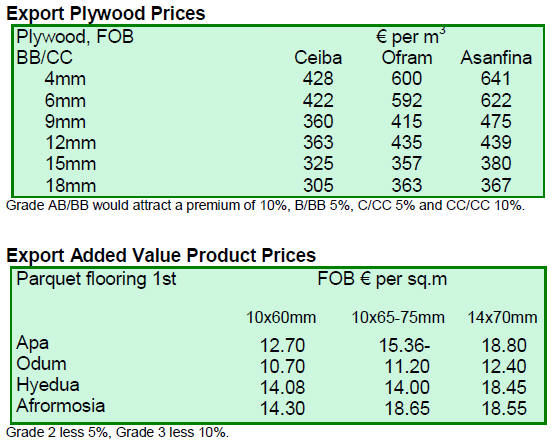
﹛
3. MALAYSIA
VPA talks put on hold
Malaysia‟s Ministry of International Trade has announced
a postponement of talks on the free trade agreement
between European Union and Malaysia.
It seems that this postponement was decided upon to allow
the Malaysian negotiators to focus on the Trans Pacific
Partnership Agreement (TPPA) talks. Analysts are
speculating that the priority previously placed on the VPA
negotiations with the EU may have shifted.
Deputy Minister Hamim Samuri was reported as saying
his ministry would now focus on the completion of the
TPPA talks and then resume the EU-Malaysia free trade
talks.
The EU Ambassador to Malaysia, Luc Vandebon,
reiterated that, upon completion of a free trade agreement
between Malaysia and the EU, both sides would have duty
free access to each other‟s markets which will benefit
exporters.
Malaysia graduated out of GSP
In other news the Trade Ministry announced that from
next year Malaysia will no longer enjoy benefits provided
through the Generalised System of Preference (GSP)
scheme offered by the EU and Turkey.
Malaysia has been graduated out of the scheme because
the country has attained the status of an upper middle
income country according to the World Bank. This change
will not affect exports to Norway, Switzerland, Russia,
Belarus and Japan.
Sabah to secure „Green capital for the future‟
Sabah has just hosted an international conference ※Heart
of Borneo‟s Natural Capital: Unleashing their potential for
sustainable grown in Sabah§.
In his welcoming address, the Sabah Forestry Department
Director Sam Mannan said Sabah commented on the
record low collection of revenues from forest activities
this year, the lowest since 1973.
Revenue from the forestry sector is expected to fall to
about RM 50 million a year for the next 20 years before
rising again as plantation resources begin to be utilised by
the timber industries.
The lower forest revenue collected in Sabah is attributed to
lower harvest levels considered sustainable to ensure, in
the words of the Minister, ※green capital for the future§.
He said the Sabah State government and the timber
industries have made huge sacrifices in the interest of long
term conservation and an endowment for future
generations.
„Heart of Borneo‟ is an initiative between Malaysia,
Brunei and Indonesia, This initiative was signed in 2005 to
protect the biological, ecological and cultural richness of
the rainforests of Borneo. The initiative focuses on the
remaining intact band of forests in the centre of the island
of Borneo.
A Minister in the Sarawak Chief Minister‟s Office
recently announced plans to gazette 20 more parks and
nature reserves in the state to protect the state‟s diverse
biological resources.
This would bring the state closer to reaching its target of
setting aside a million hectares of forests, out of total land
area of 12.4 million hectares, as totally protected areas.
The increase in protected areas will be welcomed as the
state battles wildlife poachers. The Forestry Department
intends to mount a campaign to increase awareness among
the various authorities and public on the seriousness of the
crime of poaching.
Sarawak log export trends
The Sarawak Forestry department released 2013 log
production statistics.
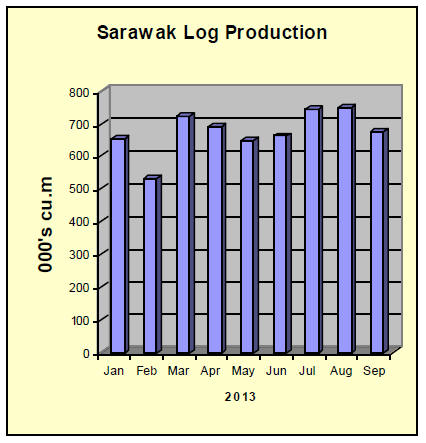
January 654,930 cu.m, February 530,441 cu.m, March
719,518 cu.m, April 692,012 cu.m, May 645,460 cu.m,
June 660,836 cu.m, July 744,505 cu.m, August 749,163
cu.m and September 674,502 cu.m.
The department also release log export market data for the
period January to September 2013.
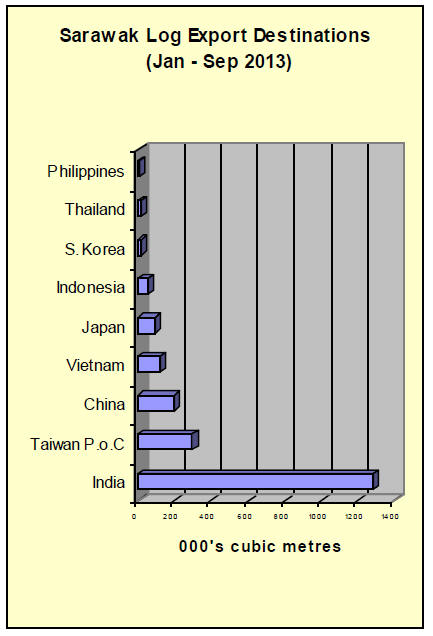
China 197,676 cu.m, India 1,282,804 cu.m, Indonesia
53,774 cu.m, Japan 93,600 cu.m, South Korea 19,330
cu.m, Taiwan 294,785 cu.m, Vietnam 123,041 cu.m,
Thailand 15,030 cu.m and Philippines 7,250 cu.m.
The total value of log exports from January to September
was RM 1,253,194,801 (approximately US$ 387.3
million).
Plywood price indications for late November
Traders in Sarawak provided the following price
indications for export plywood: from Sarawak: FB
(11.5mm) US$680 每 685 FOB, CP (3‟ x 6‟ UCP) US$530
FOB, to Middle East (9 每 18 mm) US$465 FOB, to South
Korea (8.5 每 17.5 mm) US$480 C&F, to Taiwan P.o.C
(8.5 每 17.5 mm) US$450 FOB, and to China/Hong Kong
US$460 每 480 FOB.
﹛
4. INDONESIA
Plans for massive investment in
infrastructure
Indonesia‟s Central Bank issued a press release on the
performance of the economy in the third quarter say, as
anticipated, the economy grew 5.6% in the July-to-
September period from a year earlier, down from 5.8% in
the previous quarter.
For the press release see:
www.bi.go.id/web/en/Ruang+Media/Siaran+Pers/SP_154
313_DKom.htm
The press release says ※The economic slowdown primarily
results from weak investment due to declining growth of
investment in construction as well as weak investment in
non-construction§.
The Bank considers the economic slowdown a result of the
stabilisation policy implemented by the Government and
Bank Indonesia to bring economic growth towards a more
sustainable level. Further, the Bank estimates that
economic growth for 2013 is still within the range of the
previous 5.5% to 5.9% forecast.
To boost growth the government has announced plans for
massive new infrastructure projects which will include
port improvements, new dams and roads as well as
additional power generation capacity. The poor
infrastructure in Indonesia has always been seen as a
handicap to growth.
Forestry Ministry to address rights abuses in the
sector
The Indonesian Ministry of Forestry has indicated it would
review the legal framework for forestry in an effort to
eliminate human rights abuses linked to illegal practices in
forestry.
Forestry Ministry secretary general Hadi Daryanto said
※We are open to suggestions to improve the framework
regarding timber standards, which has so far not included
terms to protect the rights of indigenous peoples. We will
review the standard for legal timber.§
The recent emphasis on rights abuses comes after Human
Rights Watch (HRW) released the Indonesian version of
its recent report, ※The Dark Side of Green Growth: Human
Rights Impacts of Weak Governance in Indonesia‟s
Forestry Sector§, regarding mismanagement in Indonesia‟s
forestry sector.
See the HRW press release at
www.hrw.org/reports/2013/07/15/dark-side-green-growth
HRW urged the government to improve the timber legality
standard, saying that the Forest Law Enforcement,
Governance and Trade Voluntary Partnership Agreement
(FLEGT-VPA) signed with the EU in Brussels, Belgium,
in September was not enough to curb rights abuses.
Demands to scrutinise forestry crimes
Indonesian law enforcement institutions have been urged
to strengthen their fight against forest crimes after the
Indonesia Corruption Watch (ICW) released a report
estimating that state losses from such crimes could have
been as much as Rp691 trillion (US$62 billion) between
2011 and 2012.
Lalola Estele, a researcher with ICW, said the total losses
had been calculated from 124 cases of forest crimes
recorded by the watchdog from 2011 to 2012.

﹛
5. MYANMAR
Massive jump in log shipments as Indian
buyers return
In October 54,500 cu.m of teak logs and 170,000 cu.m of
other hardwoods were shipped. The total volume of logs
shipped between April to the end of October was 241,000
cu.m of teak and 860,000 cu.m of hardwoods. The October
shipment volume is impressive and is the highest for the
past six months.
As India purchases the largest volume of teak (around
70%) analysts assume that that the stabilised US dollar-
Indian rupee exchange rate has encouraged Indian buyers
to ship logs.
The US$/rupee exchange rate was 54.2491 on 9 May but
fell to 68.7947 on 28August but recovered slightly to
62.4593 on 1 October. Some analysts expect log
shipments to increase with the continued easing of the
pressure on the Indian rupee.
Discrepancies in border trade statistics
The Weekly Eleven newspaper, quoting Ministry of
Commerce sources, reported that, according to China‟s
trade data, forest products valued at US$17 mil. had been
transported overland to Yunnan Province within a single
month. In contrast, figures from Myanmar‟s border
checkpoints show a much lower figure. Analysts say this
sort of discrepancy in the trade data is not a new thing but
requires investigation.
Similar disparities in export/import data appear in the
Myanmar-Thailand border areas. Unrecorded exports
along the Myawaddy and Tachileik trade routes have also
been reported.
Deforestation, an obstacle to alleviating rural poverty
At a recent meeting of the Forest Products Joint Venture
Corporation (FJV), Myanmar‟s Union Minister, Win Tun,
stressed the importance of the country‟s forest resources in
the fight against poverty. He also mentioned that
deforestation was the biggest obstacle to long term
sustainability of the environment.
The Minister explained to the gathering the need to
minimise the depletion of forests and natural resources;
preserve biological diversity; administer proper land use to
combat climate change and to successfully implement
international agreements.
FJV is a joint venture corporation with 45% of the shares
owned by MTE; 10 % by the Forest Department; and 45 %
by the public.
Thilawa special economic zone
Work on Myanmar‟s first special economic zone, the
Thilawa Special Economic Zone (SEZ) is set to begin. The
SEZ is a sprawling complex about 25 kilometres south of
Yangon.
The SEZ is 51 percent Myanmar owned and will have a
deep water port, factories and large housing projects. Last
week Japan‟s Thilawa SEZ Company Ltd. (JTSC) signed a
joint-partnership agreement in Tokyo with Myanmar
Thilawa SEZ Holdings Public Ltd. (MTSH).
The Japanese companies Mitsubishi, Sumitomo and
Marubeni have formed a joint venture to develop the
Thilawa Special Economic Zone. This planned investment
represents Japan‟s largest in Myanmar to date. For more
see:www.marubeni.com/news/2013/release/00056.html
The first challenge facing the government is to reach
agreement with land owners on compensation. The second
major challenge will be to arrange power, water and
transport facilities to service the SEZ.
Of the 51 percent ownership by Myanmar, 41 percent is
private belonging to MTSH. The first stage includes work
on 400 hectares of the 2,400-hectare Thilawa SEZ. In
2015, factories will be finished and infrastructure in the
zone will also be complete.
October teak log tender results
The following shows the grade, quantity and prices for
teak logs during the 25 and 28 October tender conducted
by the MTE. The next tender sale will be at the end of
November.
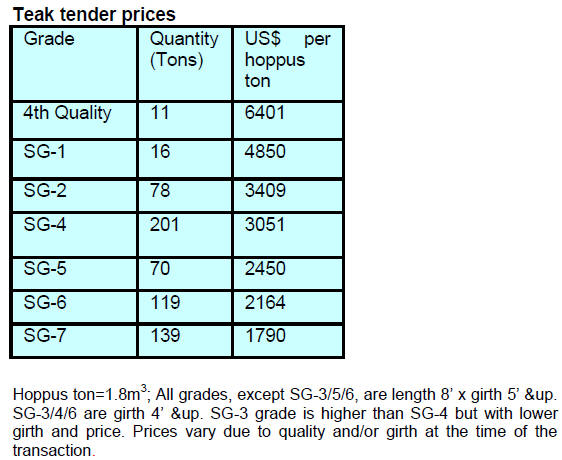
6.
INDIA
Housing market hit by inflation and high
interest rates
Positive economic news continues to drive private sector
sentiment higher. The fact that the rupee/US dollar
exchange rate remains stable is good news for importers.
Quarterly results for industrial production have improved
and companies are looking forward to good financial
results.
The only weak spot is the real estate sector where, despite
attractive offers and discounts made during the Diwali
festive season, unsold homes have reached new highs. At
the end of September figures for unsold housing stock
stood at 711 million square feet as against 670 million
sq.ft at the end of June.
The bad news is that consumer price inflation is eating up
the personal savings and the high interest rates introduced
to curb inflation are also weighing on consumers and
affecting decisions on taking loans for new homes.
This scenario hurts sales of wood and wood products and
the industry hopes the government will introduce measures
to assist those wanting to buy a home.
Farm contract planting to feed plywood mills a reality
TNAU,(Tamilnadu Agricultural University) is the largest
Agricultural University in India and its campus spreads
over 125 ha.. The university does excellent work not only
to help Agriculture but also the Forestry sector through
research and application on tree improvement to increase
opportunities for manufacturing.
In 2011 TNAU developed a hybrid of Casuarina
equisetifolia called MTP CA-1 and 2 which, besides
growing faster and having better form, has a higher
cellulose content. Similar work is underway on eucalyptus,
teak and silver oak.
Recently, the university has been promoting the idea of
contracting farmers to help the plywood industry in
Tamilnadu through the planting of a fast growing new
hybrid Melia dubia, called MTP-1 and 2 which has been
found very suitable for plywood manufacture.
The proposed farm/plantation model involves guaranteed
buy-back and assured prices as well as supportive
mechanism for the growers.
On the environmental front, the cultivation of Melia
dubia trees, it is said, will help reduce atmospheric carbondioxide
through carbon sequestration. This tree
accumulates a biomass of 300 tonnes/hectares in six years
and removes 150 tonnes of atmospheric carbon-dioxide
through sequestration.
Melia grows in a wide range of soils and the logs attract a
price of around Rs 7,500/tonne once at a girth of 20 inches
(approx 50cm.). This could mean a farmer will earn Rs 6-8
lakh per acre (Rs. 1.5-2.0 mil. per ha) within six years.
Contract „farming‟ of tree species is common for the
production of raw material for the pulp and match
industries and more than 30,000 hectares planted in the
State but the idea for „farming‟ for raw materials for the
solid wood product sector is new. As resources from
natural forests come under pressure from growing demand
there is a need for alternate sources to be created.
Western India Forest Depot auctions
Auctions at the Tapti depots of Raj Pipla, Vyara etc. held
from 20th to 25th October 2013 were successful and prices
were firm. Approximately 6000 cu.m of logs were offered
for sale at the recent auction.
Teak logs sales
Average prices recorded at the most recent auction are as
follows:
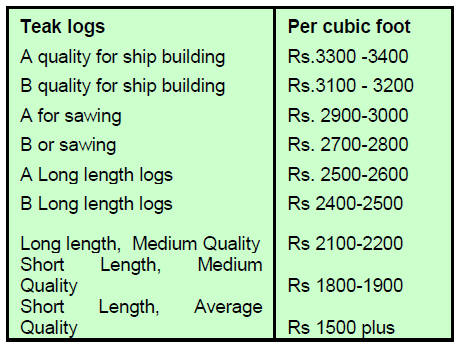
Bidding at the auction was brisk for fresh teak
logs of
desirable specifications. Unfortunately, for some medium
quality lots bids failed to achieve the reserved price and
went unsold.
Good quality non-teak hardwood logs, such as Haldu
(Adina cordifolia), Laurel (Terminalia tomentosa), kalam
(Mitragyna parviflora) and Indian Kino (Pterocarpus
marsupium) having lengths of 3 to 4 metres and girths of
91cms and up fetched prices in the range of Rs.800-900
per c.ft while medium quality logs traded at around
Rs600-700 per c.ft.
Now that the Diwali and Indian New year holidays
are
over, auctions will continue.
Imported plantation teak prices reflect wide variations
in quality
Plantation teak shipments continue to arrive irrespective of
exchange rate fluctuations as India needs to import all
types of wood including teak. Because of changed
specifications and the willingness of importers to accept
logs with smaller girths, prices have declined. On the other
hand some exporters have been shipping higher quality
logs so, for these shipments, prices have improved.
Current C & F prices for imported plantation teak, Indian
ports per cubic metre are shown below.
In the period reviewed Brazilian plantation teak logs
arrived in India at prices ranging from US$ 350-750 per
cubic metre.

Variations are based on quality, length and average girth of logs
Domestic ex-sawmill prices for air dried
sawnwood cut
from imported logs
Prices for air dry sawnwood per cubic Foot, ex-sawmill
are shown below.
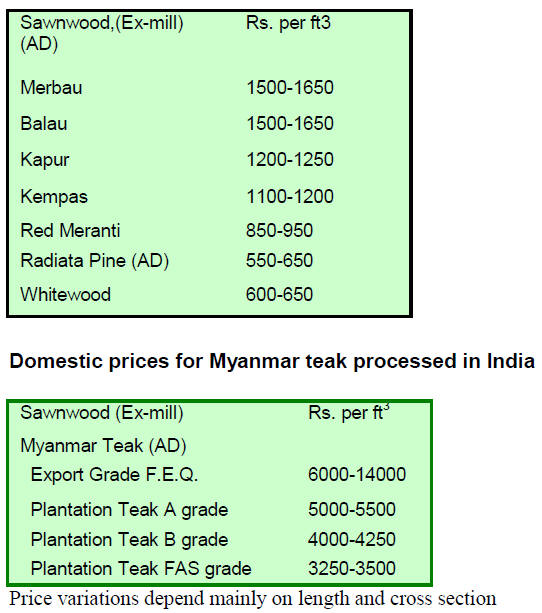
Prices for imported sawnwood
The recent slowing in the Indian economy and the weak
housing market is holding down imported sawnwood.
Ex-warehouse prices for imported kiln dry (12% mc.)
sawnwood per cu.ft are shown below.
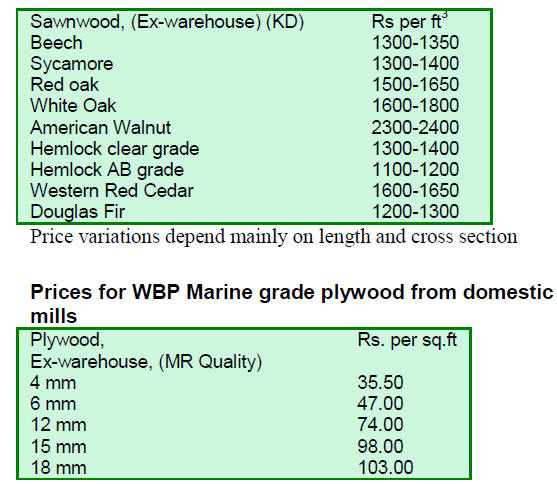
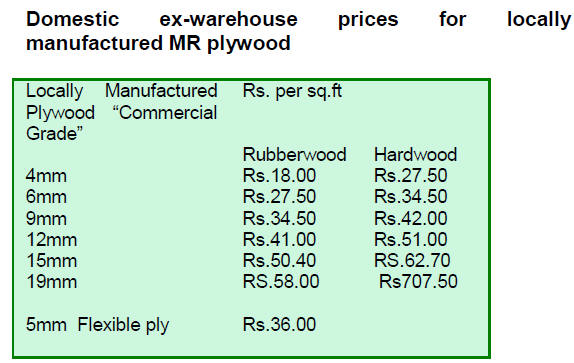
7.
BRAZIL
ABIMCI launches timber sector report
The Brazilian Association for the Mechanically Processed
Timber Industry (ABIMCI), in partnership with the
National Forum of Forest-Based Activities (FNABF), has
published a sectoral study of Brazil‟s timber industry. This
study provides the main socio-economic data and an
overview of the timber industry in Brazil.
The new study presents information such as the trade
balance in the forest-based sector which in 2012 was a
positive US$6.9 billion or 35.4% of Brazil‟s trade surplus
in that year.
The study also shows that the wood processing industries
are responsible for 72% of the output from the forestry
sector with 58,200 active companies.
Furthermore, the forestry sector added direct jobs in 2012
and the total now stands at 735,000. Other information
includes consolidated trade and market data which are
relevant for the development of strategies for the forest
sector in Brazil.
The official launch of the Sectoral Study will take place in
Brasilia in mid-November. ABIMCI also plans to promote
the study. The first phase of this promotion will be in
Europe where the results of the study will be presented to
timber and trade organizations such as the Timber Trade
Federation (TTF), the European Timber Trade Federation
(ETTF), the Global Timber Forum (GTF), the European
Plywood Federation (FEIC) and major importers.
Tax revenues from timber sector fall
The state of Mato Grosso is one of the major timber
producing states in the Amazon region. In the first half of
2013 the Tax on Goods and Services (ICMS) collected
from the forest-based sector in the state amounted to real
33 million.
Despite an increase of real 12 million in taxes collected in
the last two months the semiannual report from the State
confirmed a 10.8% decline in state tax revenue from
forestry compared with that collected in the first half of
2012.
The ICMS tax revenue from the forest-based sector has
fallen 11.6% over the past ten years. Currently, the Center
for Timber Producers and Exporters Industries of Mato
Grosso (Cipem) is working on a proposal for a new
taxation model for the timber industry. The proposal was
discussed recently during a meeting with the State Finance
Secretariat.
Furniture exports fall in January - September period
Bento Gonçalves is the main municipality in Southern
Brazil for the production of furniture. The value of
furniture exports from furniture clusters in Bento
Gonçalves from January to September amounted to
US$42.9 million.
This represents a decline of around 8% when compared to
levels in the same period last year. This performance is
worse than the fall in exports from companies in the state
of Rio Grande do Sul.
Amongst the twenty major markets serviced by exporters
in Bento Gonçalves demand from twelve weakened and
this was most noticeable for neighbouring countries in
Latin America and some countries in Africa. Colombia
remains the main market for furniture from Bento
Gonçalves, accounting for 15% of total state exports.
Price trends
Wood products prices in real increased by an average
0.7% over the past two weeks. Prices in US$, as shown in
the tables, increase by an average of 2.1%.
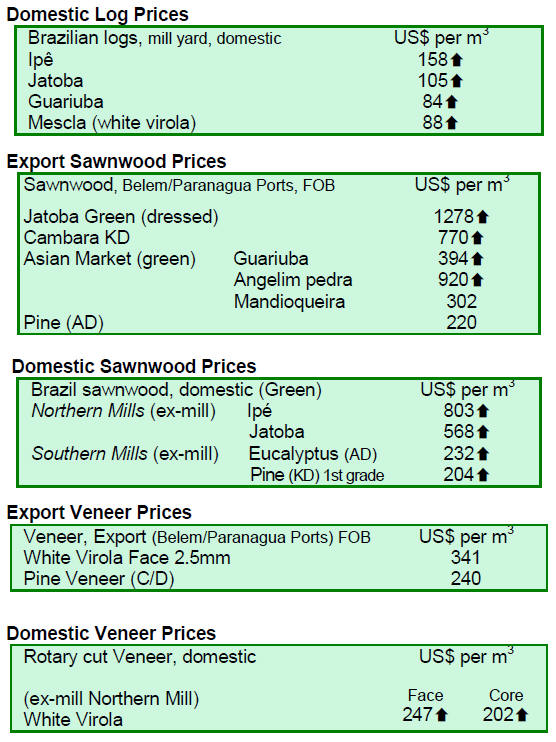
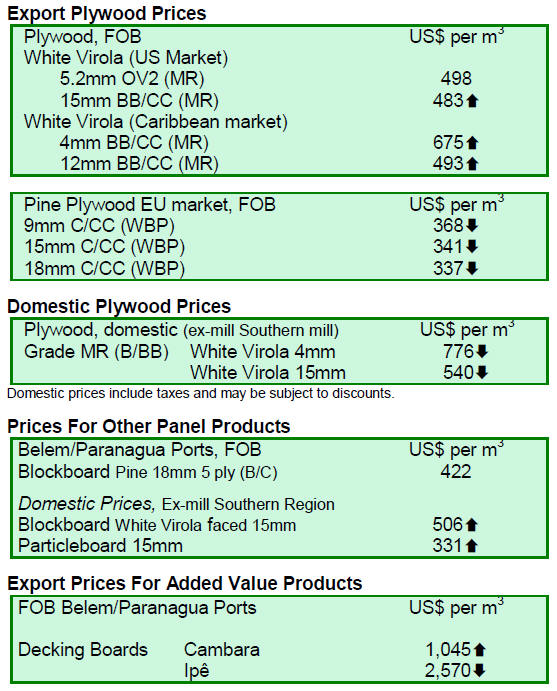
﹛
8. PERU
Wood based panel imports reach US$ 78
million
In first eight months of 2013 imports of particleboards
were valued at US$56.2 mil. while imports of MDF
totalled US$22.1 million.
The main supplier of panels was Ecuador, with shipments
valued at US$ 24.4 million and a market share of 43.5%
for imported particleboard. The second largest supplier
was Chile at US$23 million (40.9% market share)
followed by Spain US$4.6 million (8.2% share) and
Portugal US$3 million (5.4% share).
In the first eight months the main importer was Novopan
Peru with purchases worth US$22.1 million and a share of
39.3 % of all imported particleboard followed by Arauco
Peru (21.5%), Masisa Peru (19.4%) and Representative
Martin (9.4%).
For MDF, the main supplier was Chile (US$14.7 mil., 66
% share of total imports) followed by Turkey, (US$2.6
mil. 11.8% share), Uruguay, (US$1.8 mil. 8.2% share) and
Ecuador which supplied US$1.1 mil. for a 4.9%share of
total imports of MDF.
Regulations in support of Forestry and Wildlife law
discussed
The Minister of Agriculture and Irrigation (Minagri)
Milton Von Hesse, presented the details of the Forest and
Wildlife Act No. 29763 to civil society groups which have
until February next year to lodge recommendations and
observations.
After the February 2014 deadline consultations will be
held with indigenous communities as part of the
participatory process.
Already, national participatory thematic working groups
(16) have been formed to facilitate dialogue at the regional
level and to solicit contributions from other ministries
such as the Ministry of Agriculture and Irrigation,
Ministry of Environment, Ministry of Foreign Trade and
Tourism, Ministry of Culture, Ministry of Production, the
Agency for Supervision of Forest Resources and Wildlife
and regional governments.
The Ministry of Agriculture has indicated that this
regulation is complementary to other management tools
that it has developed to strengthen the sector, such as the
approval of the National Forestry and Wildlife law, the
approval of the Rules of Organization and Functions of the
National forestry and Wildlife service which will be the
new authority responsible for the stewardship of forestry
and wildlife.
In addition, there will be the National Forest Inventory
with advice from the United Nations Organization for
Food and Agriculture (FAO) and financial support from
the Government of Finland.
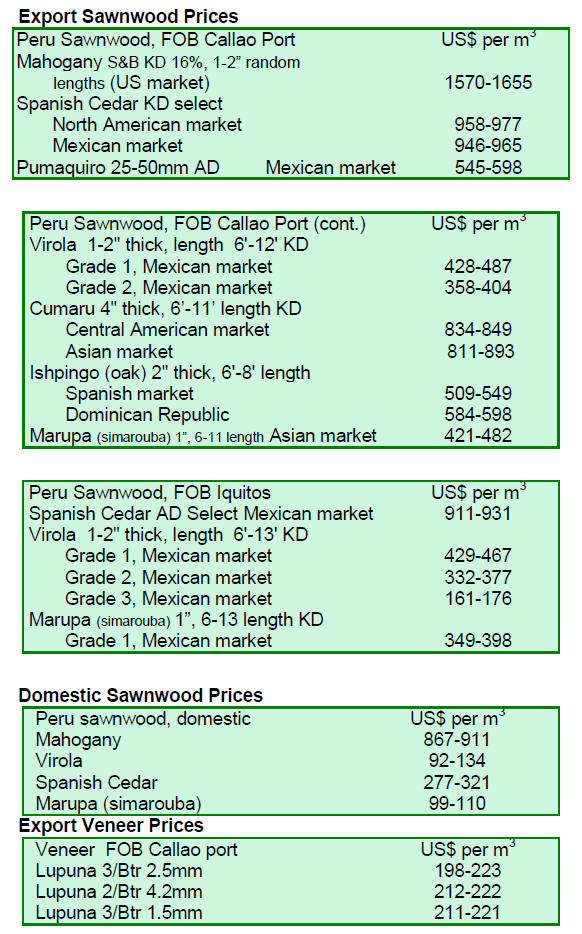
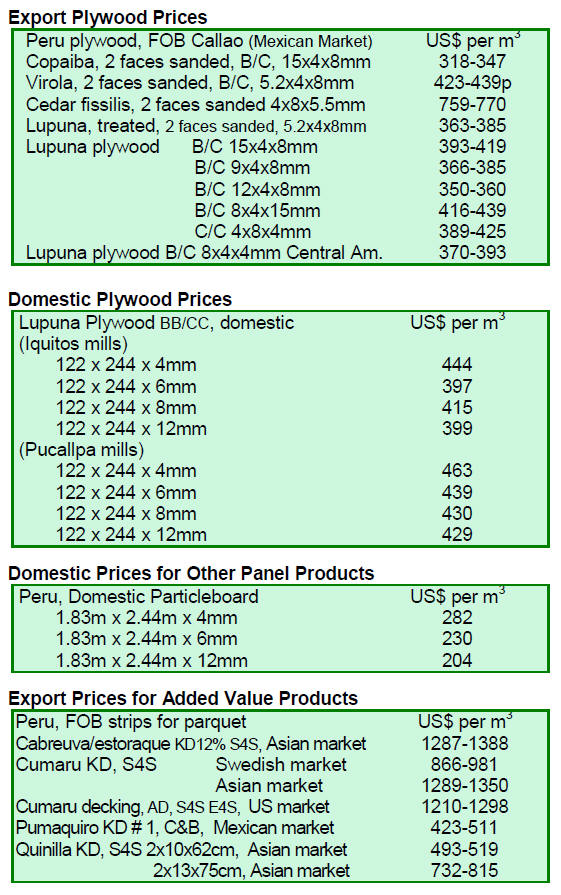
9.
GUYANA
Log exports of prime species resume
For the first time in some weeks log exports of all the
prime species resumed.
Greenheart logs were exported at prices in the region of
US$120 to US$140 FOB per cubic metre.
Prices for purpleheart logs in both the standard sawmill
quality were very favourable at US$235 per cubic metre
FOB for standard while sawmill quality logs achieved
prices of US$170 per cubic metre FOB.
Mora logs remain popular and attracted export prices
ranging from US$130 to US$160 per cubic metre FOB in
Asian and Caribbean markets.
Variable prices recorded for Undressed sawnwood
exports
FOB prices for Undressed sawn greenheart select were
between US$1,060 to US$954 per cubic metre.
In contrast, sound category Undressed sawn greenheart
FOB prices were as high as US$741 per cubic metre.
However, prices for merchantable quality experienced a
decline in top end price from US$679 to US$594 per cubic
metre FOB. The main market for Undressed Greenheart
was the Caribbean, Europe and North America.
Undressed purpleheart sawnwood saw significant price
increases during the period reviewed with Prime category
sawnwood trading at US$1,080 per cubic metre FOB.
This was matched by very attractive price offers for Select
category purpleheart sawn of US$1,993 per cubic metre
FOB sharply up from the previous FOB price of US$1,279
per cubic metre.
For Merchantable quality sawn purpleheart FOB prices
were only fair at US$ 640per cubic metre. The main
markets for Undressed purpleheart sawnwood was the
Caribbean, Oceania (New Zealand) and North America.
Undressed Mora FOB prices held firm in the export
market and only Select category mora sawnwood saw any
price movement where top end FOB prices were US$508
per cubic metre in the Caribbean and European markets.
Caribbean market sustains exports of dressed
sawnwood
Dressed sawnwood from Guyana continues to attract
favourable FOB prices on the export market; the
Caribbean was the only active market during the period
reported.
Dressed greenheart prices declined during the period
reviewed from US$1,272 to US$1,102 per cubic metre
FOB and prices for Dressed purpleheart sawnwood also
dipped slightly from US$1,290 to US$1,230 per cubic
metre.
Plywood was shipped in the period reviewed at top end
prices of US$ 584 per cubic metre FOB for markets in
Central and South America.
Prices for greenheart piles were favourable at as much as
US$613 per cubic metre FOB in markets across Europe
and North America. Wallaba poles exports also made a
notable contribution to export earning as did Splitwood
(shingles).
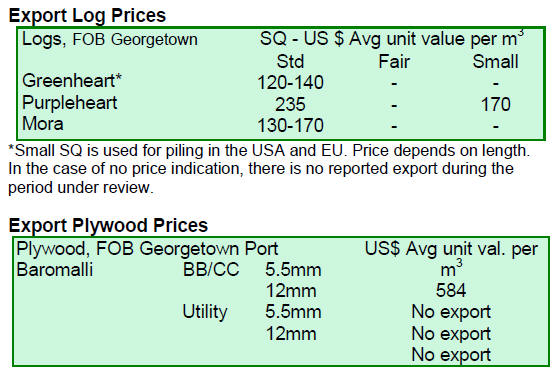
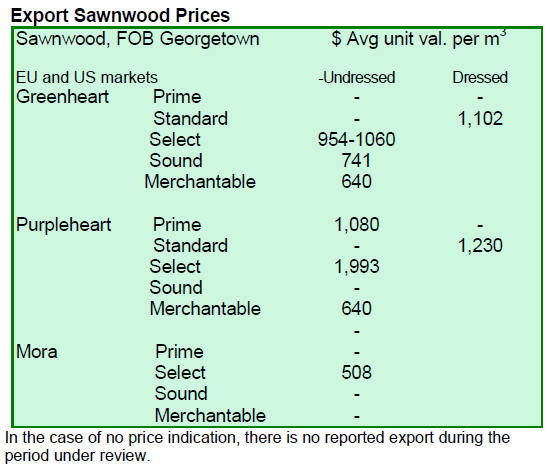
﹛
